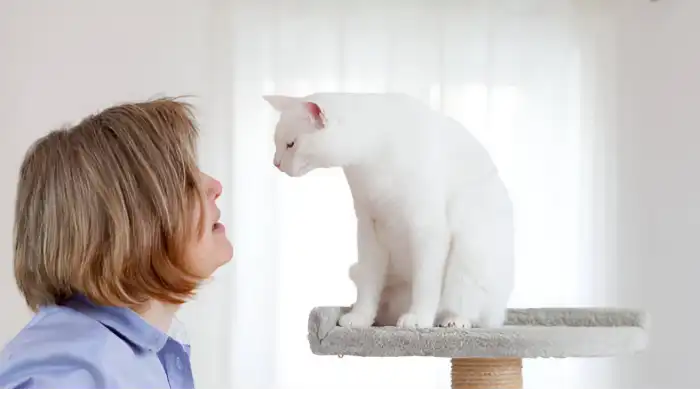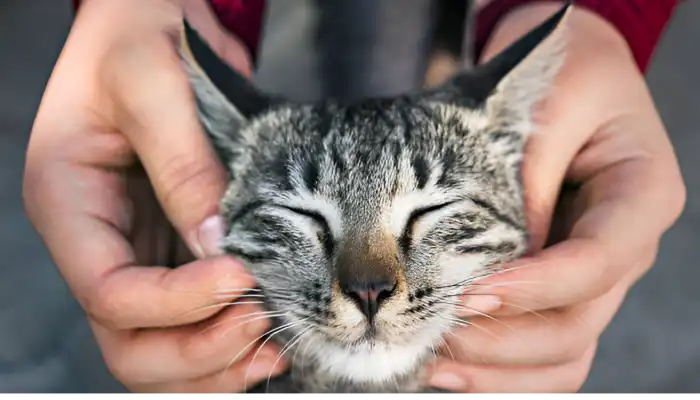Human to cat translator devices have fascinated pet owners for years, promising to decode meows, purrs, and even hisses. Ever wondered what your cat is trying to tell you at 3 a.m.? Whether it’s a demand for food or just midnight mischief, the idea of understanding feline language sounds like a dream come true. But do these cat-to-human translators actually work?
In this article, we’ll dive deep into the science, technology, and reality behind these cat Sounds translator devices. From how these human to cat translator tools claim to work to whether they’re worth your money, we’ve got you covered. Let’s unravel the mystery of feline communication together!

Human to Cat Translator: What is it?
A human to cat translator is a device or app that alphabets your cat’s sounds, gestures, and actions into a version that a person would understand. As with any other app, it seeks to solve the communication barrier that exists betweens humans and their cats. Such translators often rely on algorithms, sound segmentation, and even AIs that can do wonders to spit out what your cat “says.”
The majority of the human to cat translators rely on the following steps:
- Sound Analysis: The device captures your cat’s meows, purrs, and other sounds.
- Pattern Recognition: The system compares these sounds with a pre-recorded collection of cat vocalizations.
- Translation: A human readable output is returned, for instance, “I am hungry” or “I am annoyed.”
Some of the more sophisticated versions do assess body language as well, including tail, ear and head position for enhanced accuracy.
Science Behind Cat Communication
Before we dive into whether a human to cat translator works, it’s important to understand how cats communicate. Cats use a combination of vocalizations, body language, and scent marking to express themselves.
Common Cat Vocalizations and Their Meanings
| Sound | Possible Meaning |
|---|---|
| Meow | Greeting, demand for attention, or hunger |
| Purr | Contentment, but sometimes pain or stress |
| Hiss | Fear, anger, or a warning to back off |
| Chirp/Trill | Excitement or a friendly greeting |
| Growl | Aggression or territorial warning |
Body Language Clues
- Tail Up: Happy or confident
- Tail Puffed: Scared or agitated
- Ears Forward: Curious or interested
- Ears Flat: Angry or frightened
By understanding these points, you should be in a better position to determine whether a cat translator cat to human is realistic or just a ploy to make money off people.

Do Human to Cat Translators Actually Work?
The million-dollar question: do these devices live up to the hype? Let’s break it down.
The Pros:
- Entertainment Value – Although it may not be correct and a hundred percent effective, the devices can be used for fun and motivation to talk.
- Basic Interpretation – Some devices are able to tell specific sounds like hunger meows or even baby talk purring.
- Bonding Tool – A cat translator app increases the chances of the owner paying attention to their cat, improving the relationship between them.
The Cons:
- Limited Accuracy – Cats vary in vocal sounds and so a blanket approach doesn’t work for everyone.
- Context Matters – A single meow has different meanings that depend on many contexts, something that devices fail to consider time and again.
- Over-Reliance – Overdoing the use of translators can make individuals ignore other forms of communication expressed through actions.
Real-Life Examples:
- MeowTalk: An application that promises to convert your cat’s meows to English. It is entertaining to try but many users do not seem to have success with it.
- Catterbox: This collar offers an amusing approach to translating your cat’s meows and is less of a serious device for communication and more of a novelty product.
While human-to-cat translators can be entertaining and may offer some insights, true communication with your cat still relies on observing their behavior and body language.
An English to cat translator may help, but understanding your cat’s natural cues is essential.
How to Choose the Right Human to Cat Translator?
If you’re still curious about trying a cat translator cat to human device, here are some tips to help you pick the right one:
- Read Reviews: Look for honest user feedback to gauge accuracy and usability.
- Check Features: Does it analyze only sounds, or does it include body language too?
- Budget: Some devices can be pricey, so decide how much you’re willing to spend.
- Ease of Use: A complicated device might not be worth the effort.
Choosing the right cat meow translator depends on your needs, so pick one that balances fun, functionality, and accuracy for the best experience with your feline friend!

Limitations of Human to Cat Translators
Even though the possibility of a human to cat translator is great, the drawbacks should also be noted. Capturing the complete dimension of a cat’s emotions and intentions is impossible due to the elaborate ways through which they communicate.
- Individual Differences: Every cat is unique. The meaning behind a single cat’s meow could be completely different from what another cat’s meow signifies.
- The Importance of Context: A meow when a cat is standing next to the food bowl is most probably an indication that they are hungry. On the other hand, if they meow when they are next to the door, it is likely that they want to go outside. Such subtleties are missed by many devices.
- Non Verbal Communication: Various body language behaviors, which are the principal means of communication for cats, are usually neglected by most translators.
- Complex Emotions: Cats go through numerous feelings, and trying to condense these emotions into a few phrases can be reductive and does not take into account all their feelings.
Role of Human Interpretation:
No device at this time can replace the understanding and variance of bond that you share with your cat. Felines and humans are very different, and thus, spending time with your pet is undoubtedly the best way to understand their behavior, rather than through technology.
Though feline translators can be entertaining, knowing your feline friend well comes down to patience, observation and fostering a relationship over time.
Fun Ways to Use a Human to Cat Translator
Although these gadgets are not perfect, they can bring some joy into the life of a cat owner. Here are some effective ways to apply a human to cat translator:
- Party Trick: Use the translator at social events to showcase your cat and amuse people with your pet’s so called thoughts.
- Training Tool: Use it to note the sounds that your cat makes while playing or eating.
- Bonding Activity: Put some time in, along with your cat, and turn on the translator in order to discover your cat’s habits and preferences.
- Social Media Content: Post amusing or heartwarming translations for free so that other cat owners may benefit from them.
An underdeveloped human-to-cat translator gadget is not ideal, but it sure can help interact with your pet’s thoughts and funny ideas in a novel way.
If you’ve ever wondered how to speak cat translator style, using these apps can give you a fun starting point to mimic and understand your cat’s vocalizations.
DIY Human to Cat Translation Tips
If you’re not ready to invest in a cat translator cat to human device, here are some DIY tips to help you understand your cat better:
- Maintain A Record: Memorize the various sounds your cat makes and the circumstances that surround that particular sound. Noticing a few of them will be easier as time goes on.
- Utilize A Sound Recorder: Capture your cat’s vocalizations and play them to see whether or not you can pick out some of the familiar reoccurring sounds.
- Notice The Movements: Watch your cat’s tail, ears, and their physical position to help you understand better what message they are trying to relay.
- Respond Differently: Respond to your cat’s sounds differently. Rather than a single method, attempt giving food, attention, or playing with them to fulfill what they may have been asking.
Becoming your very own cat language translator can strengthen your bond with your pet!
Role of AI in Human to Cat Translators
Artificial Intelligence (AI) is playing an increasingly important role in the development of human to cat translators. Here’s how:
- Improved Accuracy: AI can analyze vast amounts of data to identify patterns in cat vocalizations.
- Personalization: Future devices might learn your cat’s unique sounds and behaviors to provide more accurate translations.
- Integration with Smart Devices: Imagine a cat translator cat to human device that syncs with your smart home system to automatically feed your cat when it’s hungry or play music to calm them down.
These developments sound fantastic, however, keep in mind that AI is only effective if adequate data is given to it. Cats can behave in extremely different manners, making it a hard problem to solve.
Conclusion
Human to cat translator apps offer a fun way to interpret your cat’s sounds using advanced technology. While entertaining, true understanding comes from observing their behavior and body language.
The best way to understand your cat is to spend time with them, observe their behavior, and listen to their needs. At the end of the day, no gadget can truly replace the bond you share with your pet. While a cat translator cat to human may not be the perfect solution, it is a fun and innovative step toward better communication with your feline friend.
